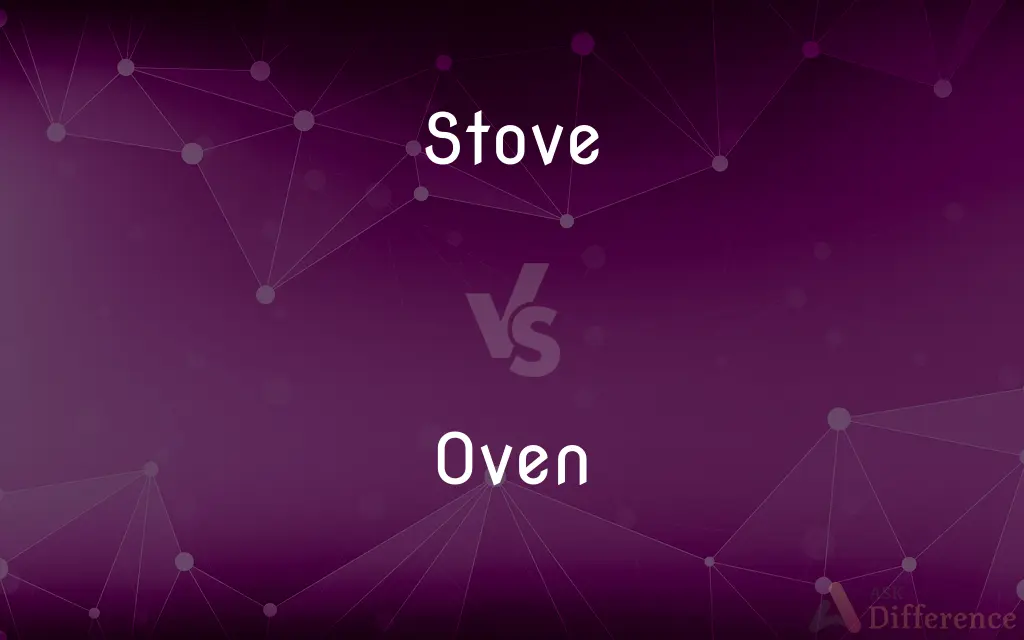Stove vs. Oven — What's the Difference?
Edited by Tayyaba Rehman — By Maham Liaqat — Updated on March 21, 2024
A stove provides a cooktop with burners for direct heating, whereas an oven offers an enclosed space for baking or roasting.

Difference Between Stove and Oven
Table of Contents
ADVERTISEMENT
Key Differences
A stove, often referred to as a cooktop, is designed for direct heating and cooking on its surface using burners or heating elements. It's commonly used for boiling, frying, and sautéing. Stoves can be powered by gas, electricity, or other fuels, and they feature knobs or controls for adjusting the heat output of the burners. On the other hand, an oven is an enclosed compartment used for baking, roasting, and broiling. Ovens maintain a consistent temperature, controlled either manually or digitally. They can be standalone units or part of a range, which combines a stove and an oven into a single appliance.
Stoves are integral for tasks requiring precise temperature control directly applied to the cookware, such as simmering or searing. They offer instant adjustments in heat, which is crucial for many cooking techniques. Ovens, however, excel in tasks that require indirect, consistent heat, like baking bread or roasting a turkey. The enclosed space of an oven distributes heat evenly around the food, which is essential for cooking through without burning the exterior.
While stoves provide a platform for cookware, requiring direct supervision and manual stirring or flipping, ovens allow for "set and forget" cooking. This means that once the temperature is set and the timer is started, the oven does the rest, making it ideal for dishes that need long, uninterrupted cooking times. Conversely, stove cooking often requires more active participation to prevent burning or uneven cooking.
Another distinction lies in the types of dishes that can be prepared. Stove cooking is typically associated with stovetop recipes like sauces, stir-fries, and pancakes, which benefit from direct heat and immediate temperature control. Ovens are better suited for baking, roasting, and broiling, where the even, surrounding heat helps create a uniform cooking environment for everything from cakes to casseroles.
In terms of energy use, stoves might use less energy for quick cooking tasks because they heat up faster and can be turned off immediately after use. Ovens, however, may require preheating and longer cooking times, potentially using more energy, but they are unparalleled for certain cooking methods that are impossible to achieve on a stove.
ADVERTISEMENT
Comparison Chart
Purpose
Direct heating and cooking on surface
Enclosed space for baking, roasting
Temperature Control
Instant adjustments
Set temperature for consistent heating
Cooking Method
Boiling, frying, sautéing
Baking, roasting, broiling
Active Participation
Required for most cooking processes
Minimal; mostly "set and forget"
Energy Use
Less for quick tasks; direct heat application
More due to preheating and longer cooking times
Compare with Definitions
Stove
A cooking appliance designed for direct heating.
The chef turned on the stove to boil water.
Oven
An enclosed space that maintains consistent temperatures.
The baker put the bread dough in the oven to rise.
Stove
An appliance used for cooking food over direct heat.
He adjusted the stove's flame to simmer the sauce.
Oven
An enclosed compartment for baking or roasting.
She preheated the oven to 350 degrees for the cake.
Stove
A cooktop featuring multiple heating elements.
The new kitchen has a gas stove with four burners.
Oven
An appliance designed for broiling, baking, and roasting.
They checked the turkey in the oven to see if it was done.
Stove
A kitchen device with burners for cooking.
She placed the skillet on the stove to fry eggs.
Oven
A device that cooks food by surrounding it with hot air.
The oven was set to broil for the chicken.
Stove
A surface where pots and pans are heated for cooking.
The soup pot was left on the stove to heat.
Oven
A kitchen appliance used for cooking with indirect heat.
The pizza was placed in the oven to bake.
Stove
A stove is a device that burns fuel or uses electricity to generate heat inside or on top of the apparatus. It has seen many developments over time and serves the main purpose of cooking food.
Oven
An oven is a tool which is used to expose materials to a hot environment. Ovens contain a hollow chamber and provide a means of heating the chamber in a controlled way.
Stove
An apparatus for cooking or heating that operates by burning fuel or using electricity.
Oven
A chamber or enclosed compartment for heating, baking, or roasting food, as in a stove, or for firing, baking, hardening, or drying objects, as in a kiln.
Stove
A hothouse for plants.
Oven
A chamber used for baking or heating.
Stove
Fumigate or disinfect (a house) with sulphur or other fumes.
Oven
(colloquial) A very hot place.
Stove
Treat (an object) by heating it in a stove in order to apply a desired surface coating.
Oven
To cook in an oven
Stove
Force or raise (plants) in a hothouse.
Oven
A place arched over with brick or stonework, and used for baking, heating, or drying; hence, any structure, whether fixed or portable, which may be heated for baking, drying, etc.; esp., now, a chamber in a stove, used for baking or roasting.
Stove
An apparatus in which electricity or a fuel is used to furnish heat, as for cooking or warmth.
Oven
Kitchen appliance used for baking or roasting
Stove
A device that produces heat for specialized, especially industrial, purposes.
Stove
A kiln.
Stove
Chiefly British A hothouse.
Stove
A past tense and a past participle of stave.
Stove
A device for heating food, (UK) a cooker.
Stove
A stovetop, with hotplates.
Stove
A hothouse heated greenhouse.
Stove
(dated) A house or room artificially warmed or heated.
Stove
(transitive) To heat or dry, as in a stove.
To stove feathers
Stove
(transitive) To keep warm, in a house or room, by artificial heat.
To stove orange trees
Stove
A house or room artificially warmed or heated; a forcing house, or hothouse; a drying room; - formerly, designating an artificially warmed dwelling or room, a parlor, or a bathroom, but now restricted, in this sense, to heated houses or rooms used for horticultural purposes or in the processes of the arts.
When most of the waiters were commanded away to their supper, the parlor or stove being nearly emptied, in came a company of musketeers.
How tedious is it to them that live in stoves and caves half a year together, as in Iceland, Muscovy, or under the pole!
Stove
An apparatus, consisting essentially of a receptacle for fuel, made of iron, brick, stone, or tiles, and variously constructed, in which fire is made or kept for warming a room or a house, or for culinary or other purposes.
Stove
An appliance having a top surface with fittings suitable for heating pots and pans for cooking, frying, or boiling food, most commonly heated by gas or electricity, and often combined with an oven in a single unit; a cooking stove. Such units commonly have two to six heating surfaces, called burners, even if they are heated by electricity rather than a gas flame.
Stove
To keep warm, in a house or room, by artificial heat; as, to stove orange trees.
Stove
To heat or dry, as in a stove; as, to stove feathers.
Stove
A kitchen appliance used for cooking food;
Dinner was already on the stove
Stove
Any heating apparatus
Common Curiosities
Is one more energy-efficient than the other?
Stoves can be more energy-efficient for quick tasks, whereas ovens might use more energy due to longer cooking times.
Are there foods that can only be cooked in an oven?
Yes, foods that require baking, like cakes and bread, are typically oven-cooked.
What is preheating and why is it important for ovens?
Preheating is warming the oven to the desired temperature before cooking, crucial for accurate cooking times and results.
Can I bake on a stove?
Traditional baking requires the indirect heat of an oven, though some stovetop methods can mimic baking.
What's the main difference between a stove and an oven?
A stove offers a cooktop for direct heating, while an oven provides an enclosed space for baking or roasting.
Can a stove and an oven be combined?
Yes, they can be combined in a single appliance known as a range.
Do stoves and ovens require different types of energy?
Both can operate on gas or electricity, depending on the model.
What's the advantage of cooking with a stove?
Stoves offer immediate heat control, crucial for many cooking techniques.
Why would I use an oven instead of a stove?
Ovens are ideal for dishes requiring even, consistent heat and minimal supervision.
Can all ovens broil food?
Most ovens have a broil function, but it's best to check the appliance's specifications.
Can an electric stove be as effective as a gas stove?
Yes, though they have different heat control dynamics, both can be equally effective.
Why do some prefer cooking with gas stoves over electric?
Gas stoves offer instant heat control and are preferred by some for their cooking precision.
Is it possible to replace a stove without replacing the oven?
If they are separate units, yes. If part of a range, they typically come together.
What maintenance does a stove require?
Regular cleaning and, for gas stoves, checking the burners for clogs.
How do I clean my oven?
Many ovens have a self-cleaning function, or you can use specific oven-cleaning products.
Share Your Discovery

Previous Comparison
Hoover vs. Hover
Next Comparison
Stock vs. RemainderAuthor Spotlight
Written by
Maham LiaqatEdited by
Tayyaba RehmanTayyaba Rehman is a distinguished writer, currently serving as a primary contributor to askdifference.com. As a researcher in semantics and etymology, Tayyaba's passion for the complexity of languages and their distinctions has found a perfect home on the platform. Tayyaba delves into the intricacies of language, distinguishing between commonly confused words and phrases, thereby providing clarity for readers worldwide.
















































